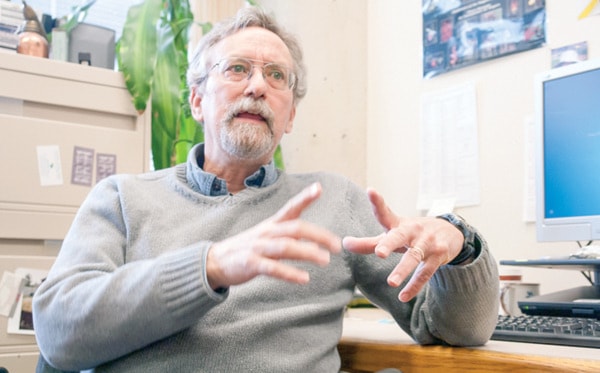Dr. Tom Lowery takes a wide-angle, inclusive approach to studying problems caused by pests in agriculture, so it’s no surprise that when being honoured with a Queen’s Jubilee medal, he took it in perspective.
“It’s not all me. I am very fortunate that I work with great people. We have a large collaborative team,” said Lowery, who extended the award to represent the efforts of other Agriculture and Agri-Food Canada researchers who work to benefit the Canadian public.
Lowery specializes in integrated pest management and the study of insect-borne plant diseases as well as supervising research at both Pacific Agri-Food Research Centre in Summerland and at the Southern Crop Protection and Food Research Centre in Vineland, Ont.
Known as a hard worker and a collaborator by his colleagues in both Ontario and B.C., industry partners see Lowery as an important researcher in entomology and plant disease vectors.
“Tom Lowery has spearheaded and supported the move to more environmentally sustainable solutions in the field of pest control,” said Hans Buchler, chair of the B.C. Wine Grape Council. “He is the one researcher responsible for industry’s shift to reduced use of pest control products, contributing to the reduction of the overall environmental footprint of wine grape production.”
“They are very interested in what we are doing. The bulk of our research is actually conducted in commercial vineyards, so we get that immediate feedback,” said Lowery, adding that including growers directly in his research helps to ensure that suggested solutions are feasible for growers to implement.
His research focusing on non-chemical methods to manage insect and mite pests of grapevines has significantly influenced cultivation practices and reduced the use of chemicals in Canada’s wine regions, notably the Okanagan. In collaboration with colleagues working in other areas of viticulture, and with support from local industry, he has played an important role in the establishment of a strong wine grape research program at PARC.
“I look at a whole system, so in this case, vineyards, and try to develop a thorough understanding of the pests and their relationships with other plants,” said Lowery.
Terroir, for him, is not just the physical soil conditions, it’s the entire environment, extending past the particular crop and pest to look at the entire system, even beyond that farm.
As an example, Lowery refers to their work with the climbing cutworm, a pest that attacks buds of grapes in the spring. After monitoring and collecting a wide range of data, including working with the growers, Lowery and his team discovered that while some vineyards were constantly plagued by the cutworms, others had no problem, had never even heard of it.
“The difference was related to the presence or absence of certain plants, ground cover vegetation in the vineyards,” said Lowery.
The particular plant of most interest was a common weed, shepherd’s purse.
“We found out that if those plants were present in the vine row then it would provide complete control of climbing cutworm. When they are small, they can live on these plants, up until they reach the third instar larvae,” said Lowery, explaining the plants are deadly to older larvae.
Many growers are now seeding their vine rows with shepherd’s purse, he said, as a way of reducing or eliminating the need to spray for the pest.
“The individual growers, many of them are interested in the well-being of not only their vineyard but the Okanagan,” said Lowery, explaining that not only is the industry interested in increasing quality of wines, but the image the area presents.
“It ties in with the Okanagan as tourist destination. If we talk about the sustainable production, the industry is also interested in this environment, its sustainability and how this is reflected.”
Lowery is also very active in the community, involved in many school activities and outings and judging at local and regional science fairs. He is a member of several community organizations, is actively involved in his son’s sports teams, and is responsible for the construction of a butterfly garden at the Summerland Ornamental Garden at PARC.
